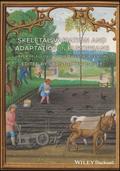Skeletal Variation and Adaptation in Europeans
Upper Paleolithic to the Twentieth Century

1. Auflage März 2018
512 Seiten, Hardcover
Wiley & Sons Ltd
A comprehensive analysis of changes in body form and skeletal robusticity from the Terminal Pleistocene through the Holocene, leading to the modern European human phenotype.
Skeletal Variation and Adaptation in Europeans: Upper Paleolithic to the Twentieth Century brings together for the first time the results of an unprecedented large-scale investigation of European skeletal remains. The study was conducted over ten years by an international research team, and includes more than 2,000 skeletons spanning most of the European continent over the past 30,000 years, from the Early Upper Paleolithic to the 20th century. This time span includes environmental transitions from foraging to food production, small-scale to large-scale urban settlements, increasing social stratification and mechanization of labor, and climatic changes. Alterations in body form and behavior in response to these transitions are reconstructed through osteometric and biomechanical analyses.
Divided into four sections, the book includes an introduction to the project and comprehensive descriptions of the methods used; general continent-wide syntheses of major trends in body size, shape, and skeletal robusticity; detailed regional analyses; and a summary of results. It also offers a full data set on an external website.
* Brings together data from an unprecedented large-scale study of human skeletal and anatomical variations
* Includes appendix of specific information from each research site
* Synthesizes data from spatial, temporal, regional, and geographical perspectives
Skeletal Variation and Adaptation in Europeans will be a valuable resource for bioarchaeologists, palaeoanthropologists, forensic anthropologists, medical historians, and archaeologists at both the graduate and post-graduate level.
Preface
List of contributors
Chapter 1: Introduction
1.1 Study Sample
1.2 Osteological Measurements
1.3 Other Variables
1.4 Organization of The Book
References
Chapter 2. Body size and shape reconstruction
2.1 Introduction
2.2 Body Size and Shape Estimation
2.3 Materials and Methods
2.4 Estimating Body Size and Shape from Skeletal Dimensions
2.5 Evaluation of Errors in Estimating Body Size and Shape from Skeletal Dimensions
2.6 Discussion and Conclusions
Acknowledgements
References
Chapter 3: Quantifying Skeletal Robusticity
3.1 Cross-Sectional Properties
3.2 Cross Section Reconstruction
3.3 Section Moduli
3.4 Standardizing for Body Size
References
Chapter 4: Temporal and geographic variation in body size and shape of Europeans from the Late Pleistocene to recent times
4.1 Environmental Adaptation
4.2 European Population History
4.3 Materials and Methods
4.4 Results
4.5 Discussion
4.6 Conclusions
References
Chapter 5: Temporal and geographic variation in robusticity
5.1 Introduction
5.2 Background
5.3 Materials
5.4 Methods
5.5 Results
5.6 Discussion
5.7 Conclusions
Acknowledgments
References
Chapter 6: Sexual dimorphism
6.1 Introduction
6.2 Materials and Methods
6.3 Results
6.4 Discussion
6.5 Conclusions
Acknowledgements
References
Chapter 7: Past human manipulative behavior in the European Holocene as assessed through upper limb asymmetry
7.1 Introduction
7.2 Materials and Methods
7.3 Results
7.4 Discussion
7.5 Summary and Conclusions
7.6 Acknowledgments
7.7 References
Chapter 8: Britain
8.1 Introduction
8.2 Body Size and Shape
8.3 Cross-Sectional Properties
8.4 Discussion
8.5 Conclusions
Acknowledgements
References
Chapter 9: France and Italy
9.1 Introduction
9.2 Samples
9.3 Methods
9.4 ResultsBody Size and Shape
9.5 Long Bone Robusticity
9.6 Discussion
9.7 Conclusions
Acknowledgements
References
Chapter 10: Iberia
10.1 Introduction
10.2 Body Size and Shape
10.3 Cross-Sectional Properties
10.4 Discussion
10.6 Conclusions
Acknowledgements
References
Chapter 11: Central European human postcranial variation
11.1 Introduction
11.2 Materials and Methods
11.3 Results
11.4 Discussion
11.5 Conclusions
11.6 Acknowledgements
11.7 References
Chapter 12: Scandinavia and Finland
12.1 Introduction to Region, Samples, And Techniques
12.2 Body Size and Body Shape
12.3 Cross-Sectional Properties
12.4 Discussion
12.5 Conclusions
Acknowledgements
References
Chapter 13: The Balkans
13.1 Introduction
13.2 Body Size and Shape
13.3 Cross-Sectional Properties
13.4 Discussion
13.4 Conclusions
Acknowledgements
References
Chapter 14: Conclusions
14.1 Body Size and Shape
14.2 Long Bone Strength
14.3 Other Bone Structural Observations
References
Appendices
Index
Christopher B. Ruff is Director of the Center for Functional Anatomy and Evolution at Johns Hopkins University School of Medicine, Baltimore, MD, USA. Dr. Ruff has published widely in the fields of human osteology, bioarchaeology, and paleontology, and has served as editor of the American Journal of Physical Anthropology and the Yearbook of Physical Anthropology.


